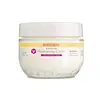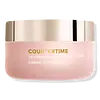What's inside
What's inside
 Key Ingredients
Key Ingredients

 Benefits
Benefits

 Concerns
Concerns

 Ingredients Side-by-side
Ingredients Side-by-side

Water
Skin ConditioningDecyl Cocoate
EmollientHelianthus Annuus Seed Oil
EmollientGlycerin
HumectantCaprylic/Capric Triglyceride
MaskingCetyl Alcohol
EmollientBakuchiol
AntimicrobialBeeswax
Emulsion StabilisingGlyceryl Stearate Citrate
EmollientStearic Acid
CleansingStearyl Alcohol
EmollientZea Mays Starch
AbsorbentTocopherol
AntioxidantGlycine Soja Oil
EmollientSclerotium Gum
Emulsion StabilisingXanthan Gum
EmulsifyingArginine
MaskingCoco-Glucoside
CleansingCetearyl Alcohol
EmollientMagnesium Aluminum Silicate
AbsorbentSodium Stearoyl Lactylate
EmulsifyingPhenoxyethanol
PreservativeWater, Decyl Cocoate, Helianthus Annuus Seed Oil, Glycerin, Caprylic/Capric Triglyceride, Cetyl Alcohol, Bakuchiol, Beeswax, Glyceryl Stearate Citrate, Stearic Acid, Stearyl Alcohol, Zea Mays Starch, Tocopherol, Glycine Soja Oil, Sclerotium Gum, Xanthan Gum, Arginine, Coco-Glucoside, Cetearyl Alcohol, Magnesium Aluminum Silicate, Sodium Stearoyl Lactylate, Phenoxyethanol
Water
Skin ConditioningButyrospermum Parkii Butter
Skin ConditioningIsononyl Isononanoate
EmollientTheobroma Cacao Seed Butter
EmollientGlycerin
HumectantCetyl Alcohol
EmollientCoconut Alkanes
EmollientCetyl Phosphate
EmulsifyingBakuchiol
AntimicrobialRhododendron Ferrugineum Extract
MaskingTetrapeptide-21
Skin ConditioningBiosaccharide Gum-1
HumectantPhytic Acid
Tocopherol
AntioxidantArginine
MaskingHelianthus Annuus Seed Oil
EmollientPotassium Sorbate
PreservativeCoco-Caprylate/Caprate
EmollientEthylhexylglycerin
Skin ConditioningButylene Glycol
HumectantXanthan Gum
EmulsifyingDisodium Phosphate
BufferingPhenoxyethanol
PreservativeWater, Butyrospermum Parkii Butter, Isononyl Isononanoate, Theobroma Cacao Seed Butter, Glycerin, Cetyl Alcohol, Coconut Alkanes, Cetyl Phosphate, Bakuchiol, Rhododendron Ferrugineum Extract, Tetrapeptide-21, Biosaccharide Gum-1, Phytic Acid, Tocopherol, Arginine, Helianthus Annuus Seed Oil, Potassium Sorbate, Coco-Caprylate/Caprate, Ethylhexylglycerin, Butylene Glycol, Xanthan Gum, Disodium Phosphate, Phenoxyethanol
Ingredients Explained
These ingredients are found in both products.
Ingredients higher up in an ingredient list are typically present in a larger amount.
Arginine is an amino acid that is important for human development. Your body uses is it to produce hair keratin and skin collagen.
As a cosmetic ingredient, Arginine has antioxidant properties and can also help repair damaged skin. This ingredient is derived either synthetically or from animals.
Arginine isn't fungal acne safe when used in the presence of other lipids (fats, fatty acids, oils, esters, etc). Oils and fats occur naturally within the skin, so take caution when using Arginine if you're prone to fungal acne.
Learn more about ArginineBakuchiol is a plant-derived antioxidant (it's vegan!). It is often called the replacement for retinol although it is not part of the same family.
It has similar effects as retinol: skin smoothing, reducing discoloration, and preventing wrinkles. It does not cause as much irritation as traditional retinoids.
Bakuchiol works by breaking down free radicals and stimulating collagen production in skin.
Combining bakuchiol with retinol will not have adverse side effects. Studies show using them will just boost the benefits. Bakuchiol is also found to help stabilize retinol.
While bakuchiol does not make the skin more sun sensitive, we recommend wearing SPF on a daily basis.
Read more about traditional retinol
Learn more about BakuchiolCetyl Alcohol is a fatty alcohol. Fatty Alcohols are most often used as an emollient or to thicken a product.
Its main roles are:
Though it has "alcohol" in the name, it is not related to denatured alcohol or ethyl alcohol.
The FDA allows products labeled "alcohol-free" to have fatty alcohols.
Learn more about Cetyl AlcoholGlycerin is already naturally found in your skin. It helps moisturize and protect your skin.
A study from 2016 found glycerin to be more effective as a humectant than AHAs and hyaluronic acid.
As a humectant, it helps the skin stay hydrated by pulling moisture to your skin. The low molecular weight of glycerin allows it to pull moisture into the deeper layers of your skin.
Hydrated skin improves your skin barrier; Your skin barrier helps protect against irritants and bacteria.
Glycerin has also been found to have antimicrobial and antiviral properties. Due to these properties, glycerin is often used in wound and burn treatments.
In cosmetics, glycerin is usually derived from plants such as soybean or palm. However, it can also be sourced from animals, such as tallow or animal fat.
This ingredient is organic, colorless, odorless, and non-toxic.
Glycerin is the name for this ingredient in American English. British English uses Glycerol/Glycerine.
Learn more about GlycerinHelianthus Annuus Seed Oil is the oil derived from the seeds of a Sunflower. Sunflower seed oil is non-fragrant. It is an emollient, meaning it helps to soften the skin.
Sunflower seed oil contains many fatty acids. The fatty acids found in sunflower seeds include (from highest amount to least): linoleic acid, myristic acid, palmitic acid, stearic acid, arachidic acid, oleic acid, and linolenic acid.
These fatty acids help the skin create ceramides. Ceramides play a role in repairing the skin barrier.
Helianthus Annuus Seed Oil helps moisturize the skin. This in turn helps the skin look more rejuvenated and smoother.
Sunflowers are rich in vitamin E.
Historians believe Indigenous cultures of North America domesticated sunflowers before corn. Thus they relied on sunflower oil for a variety of uses. One such use is moisturizing skin and hair.
Sunflower seed oil may not be fungal acne safe. We recommend speaking with a professional if you have any concerns.
Learn more about Helianthus Annuus Seed OilPhenoxyethanol is a preservative that has germicide, antimicrobial, and aromatic properties. Studies show that phenoxyethanol can prevent microbial growth. By itself, it has a scent that is similar to that of a rose.
It's often used in formulations along with Caprylyl Glycol to preserve the shelf life of products.
Tocopherol (also known as Vitamin E) is a common antioxidant used to help protect the skin from free-radicals and strengthen the skin barrier. It's also fat soluble - this means our skin is great at absorbing it.
Vitamin E also helps keep your natural skin lipids healthy. Your lipid skin barrier naturally consists of lipids, ceramides, and fatty acids. Vitamin E offers extra protection for your skin’s lipid barrier, keeping your skin healthy and nourished.
Another benefit is a bit of UV protection. Vitamin E helps reduce the damage caused by UVB rays. (It should not replace your sunscreen). Combining it with Vitamin C can decrease sunburned cells and hyperpigmentation after UV exposure.
You might have noticed Vitamin E + C often paired together. This is because it is great at stabilizing Vitamin C. Using the two together helps increase the effectiveness of both ingredients.
There are often claims that Vitamin E can reduce/prevent scarring, but these claims haven't been confirmed by scientific research.
Learn more about TocopherolWater. It's the most common cosmetic ingredient of all. You'll usually see it at the top of ingredient lists, meaning that it makes up the largest part of the product.
So why is it so popular? Water most often acts as a solvent - this means that it helps dissolve other ingredients into the formulation.
You'll also recognize water as that liquid we all need to stay alive. If you see this, drink a glass of water. Stay hydrated!
Learn more about WaterXanthan gum is used as a stabilizer and thickener within cosmetic products. It helps give products a sticky, thick feeling - preventing them from being too runny.
On the technical side of things, xanthan gum is a polysaccharide - a combination consisting of multiple sugar molecules bonded together.
Xanthan gum is a pretty common and great ingredient. It is a natural, non-toxic, non-irritating ingredient that is also commonly used in food products.
Learn more about Xanthan Gum